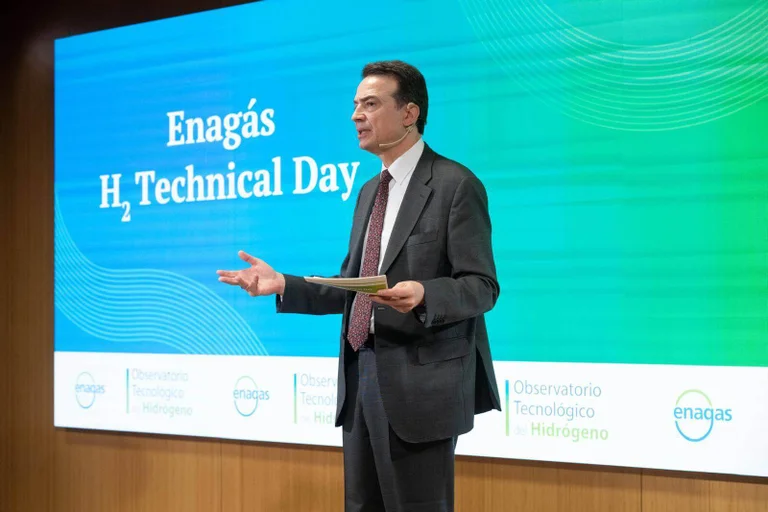Need help?
Enagás in the networks
The CEO of Enagás, Arturo Gonzalo, announced today in Madrid at the holding of the second edition of ‘Hydrogen Technical Day’ that the Grant Agreement had been signed, which means the company will be receiving 32.5 million euros from the Connect Europe Facility (CEF), granted by the European Climate, Infrastructure and Environment Executive Agency (CINEA), for the studies and engineering projects involved in the Spanish hydrogen backbone.
During the event, which had brought together leading national and international academic and industrial experts to present the latest advances in green hydrogen, Arturo Gonzalo noted that “we are making progress in the Spanish Hydrogen Backbone, as planned”, highlighting that “we are giving impetus to a new technological cycle where we will continue to take important steps as we build the hydrogen infrastructure of tomorrow.”
During his speech at the event, he also pointed out that “we are at a crucial time for hydrogen in which technology becomes a fundamental ally in making faster progress", adding that “this technology is scaling up and going to gain speed in the coming years.”
He also stressed Spain’s role as a hydrogen hub in the second auction of the European Hydrogen Bank, as the country with the most projects submitted and awarded, with a more competitive average production price. “Innovation is emerging as a differential factor to drive this transformation that Europe is leading,” said the Managing Director of Enagás, who also noted that Europe holds 28% of the patents related to this vector worldwide.

Arturo Gonzalo, CEO of Enagás, during his intervention at the event.
Hydrogen infrastructure, key to technological development
In his talk, “State of the art of hydrogen technology”; the Director of the National Hydrogen Centre (CNH2), Emilio Nieto, highlighted the over 360 Spanish renewable hydrogen projects identified to date, emphasising the technological development of hydrogen as an energy vector, including infrastructure: “The research is progressing towards the use of higher pressure ranges and the development of alternative materials,” he pronounced. In addition, he noted that “this effort has the aim of reducing the dependence on critical raw materials, which will contribute to lowering the total costs and improving the system’s long-term sustainability.”
After that, the first round-table discussion was held, entitled “Digitalisation as a Transformational Pillar throughout the Lifecycle of New Hydrogen Infrastructures”, moderated by the Director of Digitalisation and Artificial Intelligence of Enagás, Pedro del Castillo, with the participation of Roger Guimerà, a research professor at the Catalan Institution for Research and Advanced Studies (ICREA) at the Rovira i Virgili University; Natalia Matute, Director of Building Information Modelling (BIM) at BIP Consulting Spain; and Nina Bergmann, Manager of Sustainability Strategy & Office of the CEO at Siemens Iberia.
These experts agreed in highlighting the decisive role that artificial intelligence will play in the design and operation of hydrogen infrastructure, improving efficiency and predictive capacity.
The second panel addressed “The Role of Original Equipment Manufacturers in the Construction of a European Hydrogen Network”. Moderated by Pedro Rubio, Director of Technical Services and Technology at Enagás, the panel featured speakers such as Vauhini Telikapalli, Global Business Development Manager for Hydrogen at Burckhardt Compression; Marco Baldini, Hydrogen Solutions Architect at Baker Hughes; Holger Brauer, Head of R&D at Mannesmann Line Pipe; Olga Kotkowska, Business Development Team Leader at Endress+Hauser SICK; and Federico Ricotti, Valve Engineering Manager at SLB.
According to these panellists, the main technical areas which are progressing the most are in the efficiency of compression technologies, cost reduction in instrumentation, material compatibility, and predictable pricing for pipe manufacturers.
Claudio Rodríguez, General Manager of Infrastructure at Enagás and President of the European operator initiative Hydrogen Gas Assets Readiness (H2Gar), moderated the third round table, entitled "Guaranteeing the Integrity of Hydrogen Midstream Infrastructure: Challenges and Opportunities." The panel featured Iván Montero, Equipment and Materials Coordinator at Enagás and Mechanical Engineering expert; Francis Bainier, NaTran expert; Marco Tarenzi, Plant Manager for Machinery, Control Systems, and Complex Processes at Snam; José Alfredo Lana, Coordinator of Innovation and Technological Development at Enagás; Lisa Witty, Senior Engineer at National Gas; and Donatella Barbieri, Environmental Engineer at Snam.
These panellists pointed out, among other technical advances applicable to the entire “lifecycle” of transportation and storage assets, the progress made in materials characterisation and infrastructure integrity assurance, the development of risk analysis tools and operational safety assurance, as well as the availability of advanced guidelines for the design of large-scale hydrogen measurement facilities.
Entitled "R&D as an Accelerator of Green Hydrogen throughout the Value Chain," the fourth panel was moderated by Susana de Pablo, Director General of Engineering, Technology and Digitalisation. Participating in this debate were Marina Holgado, Coordinator of the Technical Secretariat of the Spanish Hydrogen Technology Platform (PteH2); Robert Judd, Secretary General of the European Gas Research Group (GERG); and Javier Navarro, member of the Hydrogen Europe Board of Directors.
These experts highlighted the strides made in research and development that are providing for improve competitiveness of the green hydrogen value chain in Europe.
Igor Pagazaurtundua, the Coordinator of the Hydrogen Technology Observatory (OTH) and Head of Innovation and Technological Development at Enagás, presented the latest advances of the OTH—created by Enagás in 2024 and already with nearly 60 partners—to promote cross-value chain collaboration and the technical advancement of renewable hydrogen. He also announced that the Observatory's next workshop will be held on 16th July, focusing on maritime transport powered by hydrogen and other green molecules.
Following the presentations and panel discussions, the General Director of the Energy Transition at Enagás, Natalia Latorre, closed the second Enagás ‘Hydrogen Technical Day’, underscoring the importance of public-private collaboration to accelerate the deployment of renewable hydrogen and reaffirming Enagás' commitment to innovation, sustainability, and leadership in the development of future energy infrastructure.
/